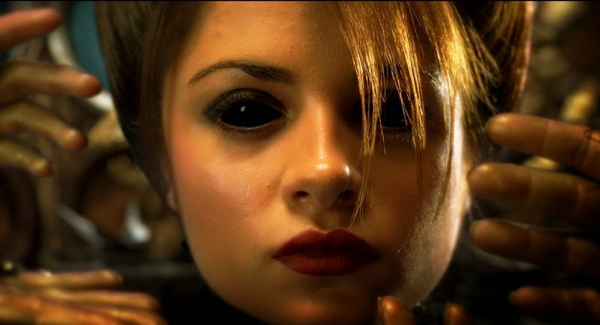Movie review by Greg Carlson
A completely disappointing mélange of computer-generated imagery and live action footage, “MirrorMask” plays out onscreen like a graphic novel come to life, but lacks the breathing room necessary to fuel the imagination of its viewers. The film brazenly wears its illustrated origins on its sleeve, as the final opening credit reads “designed and directed by Dave McKean.” It’s dubious whether design ought to share equal billing with direction, but in any case, the title is apt: McKean has made a movie stuffed to bursting with densely layered pictures. Sadly, it offers little else.
Created along with occasional partner Neil Gaiman, McKean’s dreamscape scarcely sustains thirty minutes, let alone feature length. Rebellious teen Helena (Stephanie Leonidas) can’t stand her life as a performer in her family’s traveling circus. In a reversal of the age-old chestnut, the young girl wishes to leave the big top and join the “real world.” A testy blow-up with her mother precedes a backstage collapse, and Helena blames herself for her mom’s unnamed ailment. On the eve of her mother’s operation, Helena – possibly dreaming, possibly not – disappears down the rabbit hole to enter a strange world known as the Dark Lands, where she must locate the Mirrormask, a shiny MacGuffin that will restore balance to both the fantasy realm and Helena’s waking existence.
Like “The Wizard of Oz,” “MirrorMask” presents principal actors in multiple roles, but the effort proves entirely fruitless given the film’s nonexistent character development. Helena’s guide is a masked juggler named Valentine (Jason Barry), and their awkward co-dependency is rendered even more confusing with a late suggestion that they might discover romance with one another. So much of the script adheres to a stop-start haphazardness, frustration sets in early. Helena’s mother manifests herself in three guises, but not a single one is memorable or moving. The same goes for the rest of the speaking parts.
McKean finds some success with a few otherworldly dream-inhabitants, particularly the so-called Monkeybirds, a group of gorilla-bodied creatures sporting pigeon-like heads with removable beaks. Their acrobatic presence livens up the leaden adventure for a few minutes at least. A set of rainbow-winged sphinxes challenges Helena, as does a library with flying books. Many other Dark Lands denizens resemble work done by other artists, including Hieronymus Bosch, Paul Klee, Jan Svankmajer, the Brothers Quay, and Terry Gilliam. In one strange sequence that belongs in a better movie, Helena is serenaded by a roomful of mechanized jack-in-the-box figures warbling Hal David and Burt Bacharach’s familiar tune “Close to You.”
For all the attempted visual wonder, “MirrorMask” will put most audiences to sleep. Surprisingly, for a movie about a wonderful alternate universe, there are no juicy characters. When Helena encounters the ebony-eyed Queen of Shadows, we yawn. Nothing is at stake, and everything that has led to this moment is simple-minded, empty, and devoid of interest, drama, or suspense. Weirdly, one longs for Helena’s return to her old life, which promises at least a glimmer of hope that she will interact with her mom or dad using something resembling recognizable human feelings.
